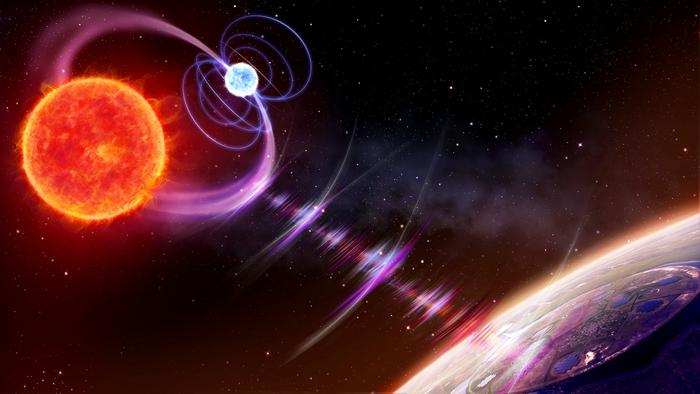
An international team led by Dr. Iris de Ruiter from the University of Sydney has made a groundbreaking discovery in the realm of astrophysics, revealing that a pair of dancing stars—a red dwarf and a white dwarf—are emitting sporadic radio pulses every two hours as they orbit one another. This elusive phenomenon, which has puzzled astronomers for years, provides new insights into the behaviors of binary star systems that can drastically alter our understanding of the cosmos. The findings represent a significant leap in our comprehension of astronomical radio signals and have the potential to reshape theories surrounding stellar interactions and emissions.
The researchers relied on advanced observational techniques, employing a combination of optical and X-ray telescopes to pinpoint the origins of the radio pulses. This breakthrough was the culmination of Dr. de Ruiter’s painstaking work while completing her doctorate at the University of Amsterdam, where she developed sophisticated methods to sift through extensive archival data. Her journey began promptly within the historical observations of LOFAR, the Low-Frequency Array telescope located in the Netherlands. It was during this phase that she identified her first pulse in data collected back in 2015, which would eventually lead to the discovery of six additional pulses emanating from a source designated ILTJ1101.
Follow-up observations conducted at prominent telescopes like the 6.5-meter Multiple Mirror Telescope in Arizona and the Hobby-Eberly Telescope in Texas painted a more comprehensive picture, confirming that the radio emissions are caused by not one but two stars engaged in a gravitational balletic dance. Positioned approximately 1,600 light-years from Earth within the Ursa Major constellation, this binary system orbits a shared center of gravity over a period of 125 minutes, a celestial choreography that raises numerous questions about the governing dynamics between different types of stars.
The interaction between the red dwarf and the white dwarf’s magnetic fields is hypothesized to be the root cause of the observed radio emissions. This revelation alters the previously held belief that neutron stars were the primary culprits behind such bright and sporadic radio signals. Until now, neutron stars had maintained a monopoly in this arena, yet the findings indicate that white dwarfs, too, have the capability to produce powerful radio bursts. This opens up promising avenues for further research and challenges the prevailing astrophysical norms surrounding star behavior.
Dr. de Ruiter remarked on the collaborative nature of the research, affirming that this discovery results from extensive teamwork across diverse astronomical fields. By combining different strategies and leveraging various technologies, her team was able to piece together a clearer understanding of these cosmic interactions. The initiative illustrates the potential for interdisciplinary cooperation in addressing some of the universe’s most enigmatic phenomena and highlights how unconventional thinking can yield transformative results in scientific inquiries.
With this discovery, astronomers anticipate delving into the ultraviolet emissions of the binary star system, which will further enlighten scientists about the thermal properties of the white dwarf. Understanding the temperature regime of such stars is crucial, as it will shed light on their evolutionary history and the intricacies of binary star evolution. The detailed observations will likely lead to new theories regarding the formation, life cycle, and eventual demise of these compact stellar remnants.
The implications of this research stretch far beyond mere academic curiosity. By unveiling how radio pulses originate from these stellar companions, the findings have profound implications for the ongoing search for similar celestial sources across our galaxy. Co-author Dr. Kaustubh Rajwade from the University of Oxford emphasized the significance of combing through LOFAR data since each newly identified pulse carries valuable information that enhances our understanding of star systems and their interactions.
Developments in observational technology have drastically improved our ability to study celestial phenomena that were once merely theoretical constructs. As radio astronomy tools become increasingly refined, scientists expect that more examples of such pulsating stars will be discovered, gradually enriching our knowledge of stellar behavior. The announcement of these findings serves as a reminder of the mysteries that still lurk in the vastness of space and affirms the notion that there is a wealth of treasures awaiting discovery amid the stars.
Additionally, researchers worldwide are inspired by this groundbreaking work to analyze historical data more meticulously to unlock further mysteries. Understanding the varied emissions from different star types could offer crucial details about stellar formations and the Health of our galaxy—an endeavor that hints at broader implications for astrophysics as we continue to grapple with the fundamental questions of our universe.
Cosmic discoveries like these galvanize not just scientific communities but also captivate public imagination and curiosity. With each revelation, the universe’s tapestry becomes woven with threads of knowledge that challenge existing paradigms and stimulate further inquiry. As such, the work surrounding the red dwarf and white dwarf binary system is bound to spark interest across various disciplines, further amplifying the importance of continuous study in the field.
In closing, the research spearheaded by Dr. de Ruiter provides a pivotal perspective on the complexities of binary star behavior and soundly showcases the collective power of modern observational techniques in unveiling the mysteries that pervade the cosmos. The team’s findings signify a momentous leap forward in astrophysical research, reminding us that the universe is filled with surprises, waiting for those brave enough to explore its depths.
Subject of Research: Binary stars and sporadic radio emissions
Article Title: A White Dwarf Binary Showing Sporadic Radio Pulses at the Orbital Period
News Publication Date: 12-Mar-2025
Web References: DOI link
References: Nature Astronomy
Image Credits: Daniëlle Futselaar/artsource.nl
Keywords
Binary stars, Red dwarfs, White dwarfs, Radio astronomy, Astrophysics, Observational astrophysics, Stellar interactions, Cosmic phenomena, Radio pulses, LOFAR data, Neutron stars, Astronomical discoveries.
Tags: advanced observational techniquesarchival data analysisastronomical radio signalsastrophysics breakthroughsbinary star systemsDr. Iris de Ruiter researchLinked dwarf starsLOFAR telescope discoveriesoptical and X-ray telescopesred dwarf and white dwarf interactionsporadic radio pulsesstellar emissions theories





